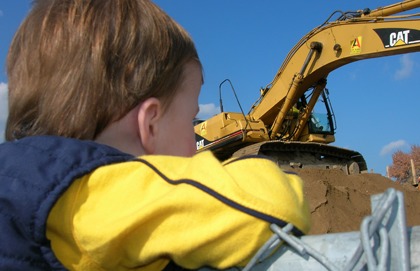Can the shape or condition of a room change you?
I have a hunch that most of us think of our buildings as inert shells. They might be pretty or ugly places, but they don't any power to change us. They're just there; we, the humans, are the actors. Rooms are places where we change our shirts, shorts, and sheets. They are places where we make love, play music, brush our teeth, eat, sleep, hold meetings, do business, pray.
But, reading this article about student housing in Waterloo last week I am reminded that this view misses something very important. Buildings are created environments, and as such they retain a latent, and very human, ability to influence us, to shape us.
Unlike traditional condos, the units are all three- and five-bedroom apartments. The building will have student-friendly features including parking, a social room in the building and on-site gym. And the units are designed to handle the rowdy student life as well with insulated concrete walls. "If you were to punch the wall, this concrete, you're basically going to break your knuckles. It's just designed in such a way that it won't be destroyed," Mr. Firsten, president of In8 Developments, said he came up with the idea for the purposed-based units after several years of owning and renting student houses in Waterloo. "What I determined was there's a lot of wear and tear," he said. "It's challenging moving kids in and out, parties in the backyards, keggers, kids punching or putting their heads through the wall. Crazy stuff."
There are a number of assumptions at play here. The apartments are meant to be close-quarter environments. They will force students to share space, and to change their habits in relationship to their roommates. But not only that, they are intended to account for what is now considered normal student behaviour: "keggers, kids putting their heads through the wall. Crazy stuff." We are a long way from the Gryffindor reading room, aren't we?
Of course, the cement walls are intended to pre-empt the actions of students in those rooms. Or, specifically, the actions of drunk students in those rooms. But, I wonder, to what extent will living in concrete rooms change those students?
We don't have to listen to our created environments, of course. We retain the ability to act in ways that go against the conditions set for us by a structure, and even begin to change the built environment itself—consider Paul and Silas singing in jail. But it would be naïve to think that such design won't have some effect on the students who live there.
The architect has designed the building with idiots in mind; might it have an unintended consequence of encouraging idiocy? Or, in another situation, might a sharp architect create a built environment which encourages good scholarship? In what ways would thinking about the character of an institution—a school, a church, a place of business, a farm—shape the institution's space? In what ways will thinking about the ways that we engage with these institutions shape our rooms? I think the possibilities for here are rich. Eric Jacobsen, for instance, has thought about this in great depth, encouraging Christians to consider the way in which built environments shape us, and how we can shape built environments in ways which account for our complexity—and potential. Perhaps, over time, we'll see a return of common room fireplaces, tapestries, and velour chairs?





